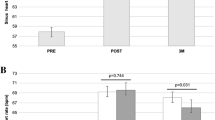Abstract
A new index of synchronisation (IS) between the electrical activity of pairs of close atrial sites during atrial fibrillation (AF) is introduced. The index assesses the probability of finding synchronous activations in intra-atrial bipolar electrograms and is based on the assumption that two activations closely spaced in time are likely to belong to the same depolarisation wavefront. A dedicated statistical treatment to test this hypothesis is also illustrated. Experimental data were obtained using a multipolar basket catheter in the right atrium in 20 patients during normal sinus rhythm (NSR), atrial flutter (AFL, one patient), high-frequency pacing (HFP, two patients) and chronic AF (17 patients), and 30 segments were obtained from each. From the 24 pairs of bipoles, a single averaged IS and its standard deviation were extracted. The IS was 1 in NSR and HFP and 0.95±0.02 during AFL. During AF, the IS provided a quantitative measure of the degree of coupling of various atrial sites. The IS varied significantly among the recording sites (range 0.38–0.96), showing a patient-dependent pattern, and decreased as the arrhythmia complexity increases. No temporal trends were observed for the IS values in any chronic AF patient. On average, in each site, the dispersion of the IS over time was lower than 32% of the mean, for all patients. Additional relevant features of the proposed index are its high temporal resolution (2s) and robustness to activation time estimation error, to missing or false detections and to the ever-changing pattern of propagation. The index of synchronisation is a descriptor of the electrophysiological properties of atrial tissues.
Similar content being viewed by others
References
Allessie, M. A., Lammers, W. E. J. E. P., Bonke, F. I. M., andHollen, J. (1985): ‘Experimental evaluation of Moe's multiple wavelet hypothesis of atrial fibrillation’ inZipes, D. P. andJalife, J. (Eds): ‘Cardiac Electrophysiology and Arrhythmias’ (Grune and Stratton, New York, 1985), pp. 265–276
Barbaro, V., Bartolini, P., Calcagnini, G., Censi, F., Michelucci, A., Macioce, R., andMorelli, S. (2000): ‘Synchronization of right atrial electrical activity during atrial fibrillation using multipolar basket catheter’,Comput. Cardiol.,27, pp. 95–98
Botteron, G. W., andSmith, J. M. (1995): ‘A technique for measurement of the extent of atrial activation during atrial fibrillation in the intact human heart’.IEEE Trans. Biomed. Eng.,42, pp. 579–586
Censi, F., Barbaro, V., Bartolini, P., Calcagnini, G., Michelucci, A., Gensini, G. F., andCerutti, S. (2000): ‘Recurrent patterns of atrial depolarization during atrial fibrillation assessed by recurrence plot quantification,”Ann. Biomed. Eng.,28, pp. 61–70
Chiang, C. J., Jenkins, J. M., andDiCarlo, L. A. (1994): ‘Digital signal processing chip implementation for detection and analysis of intracardiac electrograms’PACE,17, pp. 1373–1379
Gerstenfeld, E. P., Sahakian, A. V., andSwiryn, S. (1996): ‘Evidence for transient linking of atrial excitation during atrial fibrillation in humans’,Circulation,86, pp. 375–382
Hoekstra, B. P. T., Diks, C. G. H., Allessie, M. A., andDeGoede, J. (1995): ‘Non-linear analysis of epicardial atrial electrograms of electrically induced atrial fibrillation in man’,J. Cardiovasc. Electroph.,6, pp. 419–440
Konings, K. T., Kirchhof, C. J., Smeets, J. R., Wellens, H. J., Penn, O. C., andAllessie, M. A. (1994): ‘High-density mapping of electrically induced atrial fibrillation in humans’,Circulation,89, pp. 1665–1680
Mainardi, L. T., Porta, A., Calcagnini, G., Bartolini, P., Michelucci, A., andCerutti, S. (2001): ‘Linear and non-linear analysis of atrial signals and local activation period series during atrial-fibrillation episodes’,Med. Biol. Eng. Comput.,39, pp. 249–254
Moe, G. K. (1962): ‘On the multiple wavelet hypothesis of atrial fibrillation’,Arch. Int. Pharmacodyn. Ther.,140, pp. 183–188
Ndrepepa, G., Caref, E. B., Yin, H., El-Sherif, N., andRestivo, M. (1995): ‘Activation time determination by high-resolution unipolar and bipolar extracellular electrograms in the canine heart’,J. Cardiovasc. Electrophysiol.,6, pp. 174–188
Pitschner, H. F., Berkovic, A., Grumbrecht, S., andNeuzner, J. (1998): ‘Multielectrode basket catheter mapping for human atrial fibrillation’,J. Cardiovasc. Electrophysiol.,9, pp. S48-S56
Ropella, K. M., Sahakian, A. V., Baerman, J. M., andSwiryn, S. (1989): ‘The coherence spectrum. A quantitative discriminator of fibrillatory and nonfibrillatory cardiac rhythms’,Circulation,80, pp. 112–119
Sahakian, A., Ropella, K., andSwiryn, S. (1992): ‘Atrial electrograms and the characterization of atrial fibrillation’,J. Electrocardiol.,24, pp. 131–133
Shkurovich, S., Sahakian, A. V., andSwiryn, S. (1998): ‘Detection of atrial activity from high-voltage leads of implantable ventricular defibrillator using a cancellation technique’,IEEE Trans. Biomed. Eng.,45, pp. 229–234
Sih, H. J., Zipes, D. P., Berbari, E. J., andOlgin, J. E. (1999a): ‘A high-temporal resolution algorithm for quantifying organization during atrial fibrillation’,IEEE Trans. Biomed. Eng.,46, pp. 440–450
Sih, H. J., Zipes, D. P., Berbari, E. J., et al. (1999)b: ‘A high temporal resolution algorithm for quantifying organization during atrial fibrillation’,IEEE Trans. Biomed. Eng.,46, pp. 440–450
Tse, H. F., andLau, C. P. (1998): ‘Electrophysiological properties of the fibrillating atrium: implications for therapy’,Clin. Exp. Pharmacol. Physiol.,25, pp. 293–302
Wells, J. L., Karp, R. B., Kouchoukos, N. T., Maclean, W. A. H., James, T. N., andWaldo, A. L. (1978): ‘Characterization of atrial fibrillation in man: studies following open-heart surgery’,PACE,1, pp. 426–438
Author information
Authors and Affiliations
Corresponding author
Rights and permissions
About this article
Cite this article
Barbaro, V., Bartolini, P., Calcagnini, G. et al. Measure of synchronisation of right atrial depolarisation wavefronts during atrial fibrillation. Med. Biol. Eng. Comput. 40, 56–62 (2002). https://doi.org/10.1007/BF02347696
Received:
Accepted:
Issue Date:
DOI: https://doi.org/10.1007/BF02347696




